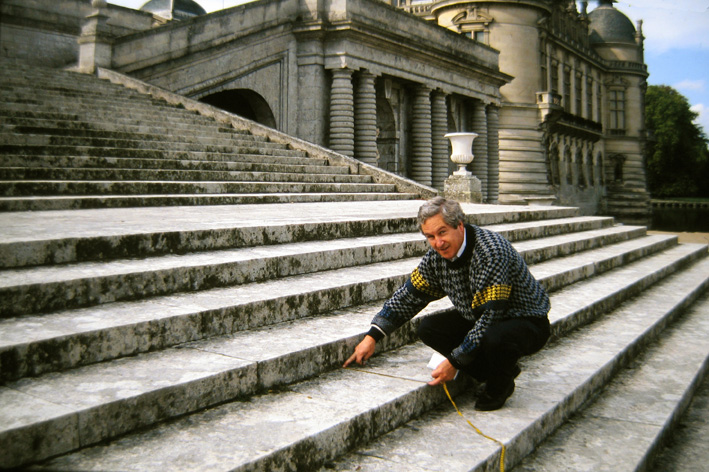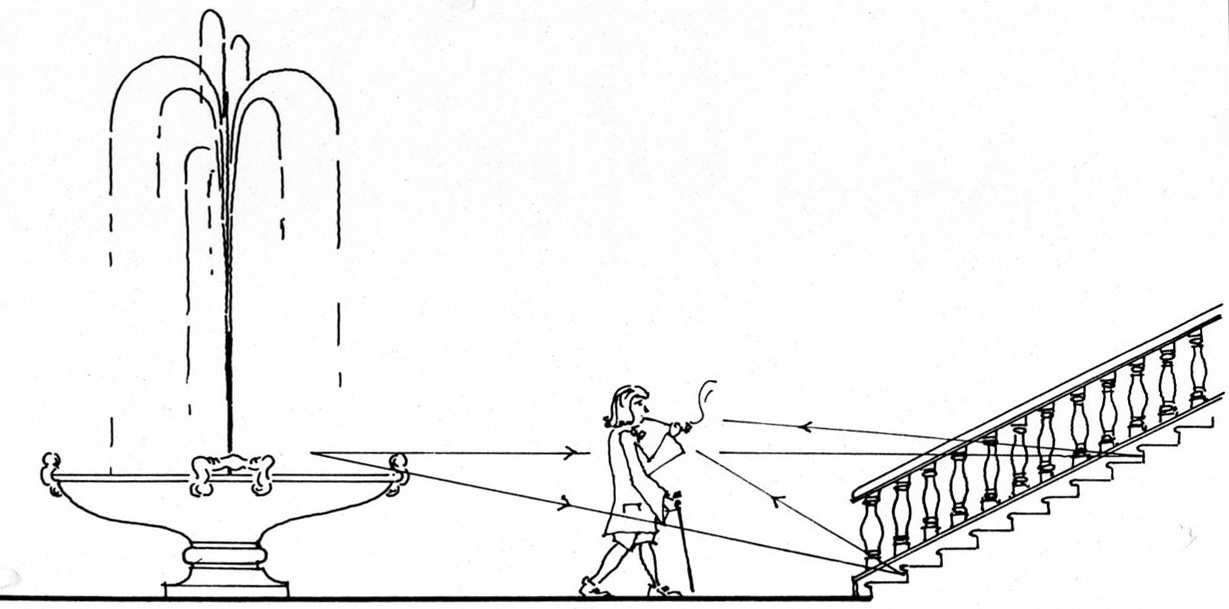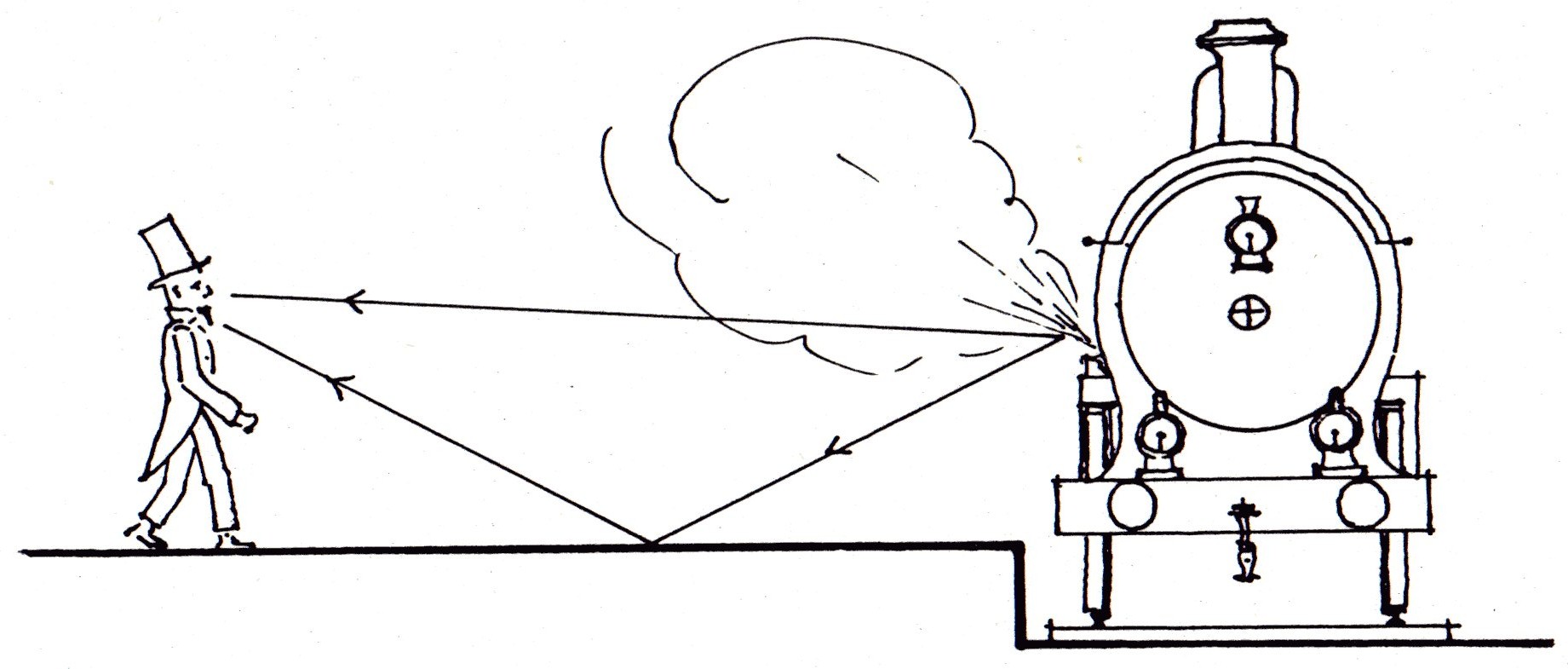Welcome to the
homepage of Frans A. Bilsen
Professor emeritus
in biophysics and acoustics at Delft University of
Technology.
I am still engaged in some interesting stuff, along with
a special item for the grand children. Please, mouse
click the topic you are interested in:
For your convenience, PDF
files of papers not easily available:
Bilsen 1966, Bilsen 1967, Bilsen 1967/68, Bilsen & Ritsma
1967/68, Bilsen
& Ritsma 1969/70,
Ritsma & Bilsen
1970, Bilsen 1973, Bilsen &
Raatgever 1973, Bilsen
1972, Bilsen
& Wesdorp 1974,
Bilsen &
Raatgever 1983, Bilsen
1994, Bilsen 1995, Bilsen & Dols 1995,
Bilsen 2001, Bilsen &
Raatgever 2001, Bilsen &
Raatgever 2002
|

at Chantilly castle in 1993
|
Note on Bilsen 2001, "The case
of the missing central spectra". Using a better (unbiased)
psychophysical procedure, the latter pilot results reported on
DRP could not be confirmed. On the contrary, the results by
Bilsen and Goldstein (JASA 1974) could be confirmed.
Repetition Pitch
A
pitch
sensation often occurs in free nature when the sound of a sound
source reaches the ear of an observer directly and, at the same
time, after being reflected against a sound-reflecting surface.
This phenomenon has been named Repetition Pitch (RP), because the
addition of a true repetition of the original sound to itself is
the basic requirement (Bilsen, 1966). RP corresponds to the
reciprocal value of the time delay between the original and the
repeated (reflected, delayed) sound. RP is most salient when the
original sound is wide band and pitch-less itself (for example:
white noise).
Probably
the first written report of the phenomenon dates from
Christian
Huygens (1693), who observed such a pitch in the sound from
a fountain reflected against the steps of a large stone staircase
in the garden of the castle of Chantilly in France (see Oeuvres
Complètes, Vol.10, Correspondance no.2840, pages 570-571,
see
Gallica;
see
DBNL, see also
RPnature).
A similar example stems from
the Mayan step pyramid in Chichen Itza (see ocasa; for a
detailed explanation see RPglide).
In free field, one might also be able to observe a gliding
pitch when a plane flies over, by moving one's head towards and
from the ground. Or more nostalgic, when one approaches a steam
locomotive blowing off steam. In music, the phenomenon is
sometimes deliberately created by electronic means (delay and add)
to superimpose a pitch or coloration effect on the original music
(see
Flanging).
In
room
acoustics
and sound recording, the phenomenon often causes an unwanted
coloration of the original sound. Blind peoples might use RP to
locate obstacles by clicking the street surface with their cane,
thus producing a wide-band impulsive sound that is reflected by an
obstacle.
Numerous experiments in the past,
in the field of psychological and physiological acoustics, aimed
at understanding the perceptual and neurological processes
underlying pitch perception in general, RP in particular. Both
temporal and spectral models of pitch extraction were proposed (RP-prediction;
see also References).

 Pictures drawn by F.M.M, Bilsen
Pictures drawn by F.M.M, Bilsen
Sound examples:
- RP+ Two-octave scale in
repetition pitch from digital noise delayed and added to
itself, stretching from G2 (10.20 ms delay) to G4 (2.55 ms
delay),
- RPm Two-octave scale from noise
with many mutually-equal-distant repetitions added (named IRN by
Yost, 1996), thus producing an intensified RP,
- Locanimat A digital animation
with intensified RP illustrating the perception of pitch or
coloration due to a single sound reflection from the ground,
- Locomovie Fragment taken from an
arbitrary movie showing a steam locomotive passing by and
producing a changing RP sound at a (fixed) microphone,
- Chantilly Video of
handclapping at the staircase of the castle Chantilly. Note a
rather salient RP due to mutually-equal-distant reflections
(compare IRN),
- Chichen Itza Three sounds in
sequence: a handclap, the pyramid's response (from ocasa), and
a synthesized RP glide following the pyramid's dimensions.
Three key publications:
- Bilsen, F. A., and Ritsma, R. J. (1967/68).
“Repetition pitch mediated by temporal fine structure at
dominant spectral regions,” Acustica 19, 114-115. PDF
- Bilsen, F. A. (1977). “Pitch of noise
signals: evidence for a ‘central spectrum’,” J. Acoust. Soc.
Am. 61, 150-161.
- Sayles, M., and Winter, I.M. (2007). “The
temporal representation of the delay of dynamic iterated
rippled noise with positive and negative gain by single
units in the ventral cochlear nucleus,” Brain Res.
2007.06.098
Dichotic pitch
A dichotic or binaural pitch may
be observed when continuous white noise is presented by headphones
to the left and right ear of a listener. Given a particular
interaural phase relationship between the left and right ear
signals, a sensation of
pitch occurs. In
other words, stimulation of either ear alone gives rise to the
sensation of white noise only, but stimulation of both ears
together produces the pitch. Generally, a dichotic pitch is
perceived somewhere in the head amidst or separate from the
background noise. To be more specific, the dichotic pitch is
characterized by three perceptual properties: pitch value, timbre,
and in-head position (lateralization) of the pitch image. The
first binaural pitch phenomenon reported in the literature is the
so-called
Huggins
Pitch (HP) (Cramer and Huggins, 1958). In this case, the
interaural phase relationship consists of a rather sharp phase
shift over 2
pi radians in a
narrow-band frequency region of the white-noise spectrum. The
sensation is of a fluctuating pure tone. Probably the strongest
dichotic pitch ever is created by having several
harmonically-related phase-shift regions. It is therefore called
multiple-phase-shift pitch (MPSP, Bilsen, 1976; see also
sirl
for a similar stimulus). Experiments on dichotic pitch were
motivated by the study of pitch in general and of the binaural
system, being crucial for
sound
localization and separation of sound sources (see
cocktail
party
effect). Various models were developed in the past.
Especially, the so-called CAP-CS model seems successful in
predicting both the pitch value and pitch-image position
(see References).
Sound examples*:
- MPSP+ Two-octave scale in MPS
pitch, stretching from G2 (98 Hz) to G4 (392 Hz). The pitch
image is perceived in the center of the head,
- MPSP- Two-octave scale in the
same pitch range. Due to the extra interaural phase shift of pi
radians, the pitch image now is perceived off center,
- HP+ Two-octave scale in Huggins
pitch (HP) stretching from C4 (262 Hz) to C6 (1047 Hz). This
sounds as a fluctuating pure tone in head centered,
- HP- Two-octave scale in the same
range. Again, due to the extra interaural phase shift of pi
radians, the pitch image now is perceived off center.
* sound tracks taken
from the audio compact disc with booklet "Demonstrations of
Dichotic Pitch" by F.A. Bilsen and J. Raatgever (Delft, 2002),
* It may be evident that
dichotic-pitch stimuli should be listened to properly with
good-quality headphones only.
Three key publications:
- Fourcin, A.J. (1970). “Central pitch and auditory
lateralization,” in Frequency Analysis and Periodicity
Detection in Hearing, ed. R. Plomp and G. F. Smoorenburg
(A. W. Sijthoff, Leiden), pp. 319-328.
- Raatgever, J., and Bilsen, F. A. (1986). “A central spectrum
theory of binaural processing. Evidence from dichotic pitch,” J.
Acoust. Soc. Am. 80, 429-441.
- Bilsen, F.A., and Raatgever, J. (2000). “On the dichotic pitch
of simultaneously presented interaurally delayed white noises.
Implications for binaural theory,” J. Acoust. Soc. Am. 108,
272-284.
Hearing aids
One of the problems with
conventional hearing aids is malfunctioning in situations with
disturbing background noise like, for example, in a cocktail-party
or meeting-like situation. Therefore, around 1983, I proposed a
project at the Delft University of Technology aiming at a new type
of hearing aid that would enable hard-of-hearing peoples to focus
on a particular voice amidst of other disturbing voices and/or
noises. In general, three strategies seem feasible: 1) the use of
two identical conventional hearing aids, provided that both ears
have degraded about equally, 2) the use of a conventional hearing
aid supplied with binaural-like signal processing, and 3) the use
of one or two conventional hearing aids with a strong directional
microphone. Given the knowledge and experience available in the
TUD
Sound
Control Group, the latter option was chosen and this has
resulted in the "
hoorbril",
a
pair of spectacles with an array of microphones mounted either on
the legs (endfire array) or on the body itself above the glasses
(broadside array). Financial support was supplied by the Dutch
Organization for Scientific Research (NWO) and the Philips
Company. Today, the company
Varibel
produces and sells an
hoorbril
based on the endfire principle. See also
Babble for similar products.
Specific publications:
- Bilsen, F.A., Soede, W., and Berkhout, A.J. (1993).
“Development and assessment of two fixed-array microphones for
use with hearing aids,” J. Rehab. Res. Developm. 30, 73-81.
- Soede, W., Berkhout, A.J., and Bilsen, F.A. (1993).
“Development of a directional hearing instrument based on
array technology,” J. Acoust. Soc. Am. 94, 785-798.
- Soede, W., Bilsen, F.A., and Berkhout, A.J.
(1993). “Assessment of a directional microphone array for
hearing-impaired listeners,” J. Acoust. Soc. Am. 94,
799-808.
Acoustics and biophysics
Here you will find a list of publications in english by coworkers of
the former research group named "Biologische Natuurkunde" (Biophysics, from 1967 headed
by Prof.dr. G. van den Brink) and re-named "Akoestische Perceptie" (Perceptual
Acoustics, untill 2002 headed by Prof.dr.ir. F.A. Bilsen) on acoustical topics,.
Classical mechanics
Basics
summarized
In classical mechanics, the movement of rigid bodies is generally
described by two analogous vector equations:
F = d
p/dt for translation of the center of mass, and
M = d
L/dt for rotation around the center of mass, with
F the total external
force,
p the momentum
(dutch:
impuls),
M the moment of forces (
koppel of krachtmoment),
and
L the angular
momentum (
impulsmoment).
TippeTop explained
As an example, we consider the intriguing movement of the
so-called
tippe
top or Kelvin top after its inventor
Lord Kelvin
(Sir William Thomson). Such a top essentially consists of a
spherical body and a cylindrical stem, with the center of mass
displaced from the center of the sphere. After having been put
into rotation around its axis of symmetry vertically, the top
gradually changes its movement and eventually it flips over into a
stable rotation on and around the stem. We have to conclude that
the rotation has changed sign, such that
the angular momentum vector
L still has its original
vertical position. Further, the center of gravity has moved
upwards, apparently at the cost of a decrease in magnitude of
L. This unexpected behavior is
explained by the action of a small friction force
at the contact point of the
top with the ground surface. Many publications in the past have
been devoted to the explanation of the complex movement of the
tippe top. Here we propose a qualitative
explanation
using the above equations only. For further details and
demonstrations see
TippeTop1
and
TippeTop2
Spinner showing precession
This recent hype flywheel thing can also learn us a lot
about classical mechanics
movie A Spinner is
mounted on a pencil suspended by a rope. It is started rotating
firmly. Its angular momentum
L
is directed horizontally along the pencil. A moment
M due to the gravital force
works perpendicular on
L.
It can only change the direction of
L, not its magnitude. The resulting rotation of
L in a horizontal plane is
called precession.
Model trains
Enjoy a movie (Bilsstadt1) or slide
show (Bilsstadt2) of our model train setup.


 Pictures drawn by F.M.M, Bilsen
Pictures drawn by F.M.M, Bilsen